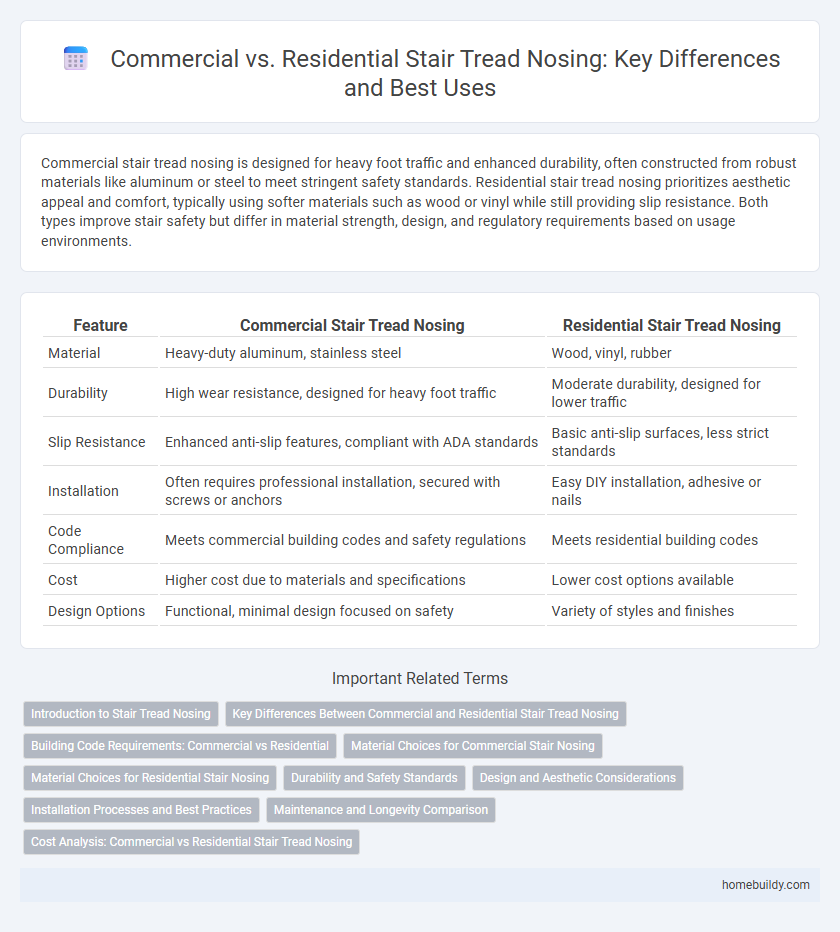Commercial stair tread nosing is designed for heavy foot traffic and enhanced durability, often constructed from robust materials like aluminum or steel to meet stringent safety standards. Residential stair tread nosing prioritizes aesthetic appeal and comfort, typically using softer materials such as wood or vinyl while still providing slip resistance. Both types improve stair safety but differ in material strength, design, and regulatory requirements based on usage environments.
Table of Comparison
| Feature | Commercial Stair Tread Nosing | Residential Stair Tread Nosing |
|---|---|---|
| Material | Heavy-duty aluminum, stainless steel | Wood, vinyl, rubber |
| Durability | High wear resistance, designed for heavy foot traffic | Moderate durability, designed for lower traffic |
| Slip Resistance | Enhanced anti-slip features, compliant with ADA standards | Basic anti-slip surfaces, less strict standards |
| Installation | Often requires professional installation, secured with screws or anchors | Easy DIY installation, adhesive or nails |
| Code Compliance | Meets commercial building codes and safety regulations | Meets residential building codes |
| Cost | Higher cost due to materials and specifications | Lower cost options available |
| Design Options | Functional, minimal design focused on safety | Variety of styles and finishes |
Introduction to Stair Tread Nosing
Commercial stair tread nosing is engineered to meet stringent safety standards, offering enhanced durability and slip resistance suitable for high-traffic environments. Residential stair tread nosing focuses on aesthetic appeal and comfort while providing adequate protection against wear and slips in lower-traffic settings. Both types play a crucial role in extending stair lifespan and ensuring user safety by reinforcing the edge of each step.
Key Differences Between Commercial and Residential Stair Tread Nosing
Commercial stair tread nosing is designed to meet strict building codes and safety regulations, often featuring durable materials like aluminum or rubber to withstand heavy foot traffic and reduce slip hazards. Residential stair tread nosing prioritizes aesthetic appeal and comfort, typically using wood or vinyl materials compatible with home interiors. The key differences lie in durability requirements, compliance standards, and material choices tailored to high-traffic commercial environments versus lower-traffic residential settings.
Building Code Requirements: Commercial vs Residential
Commercial stair tread nosing must comply with strict building code requirements such as the International Building Code (IBC), mandating slip resistance, visibility, and durability to ensure safety in high-traffic areas. Residential stair tread nosing typically follows less stringent codes like the International Residential Code (IRC), focusing on basic safety and aesthetic integration within homes. Compliance differences reflect varying risk levels, with commercial nosing often requiring thicker materials, enhanced grip surfaces, and contrasting color strips for maximum hazard prevention.
Material Choices for Commercial Stair Nosing
Commercial stair tread nosing typically uses heavy-duty materials such as aluminum, stainless steel, or durable rubber compounds designed to withstand high foot traffic and meet stringent safety codes. These materials offer enhanced slip resistance and impact durability, ensuring longevity in public or industrial environments. In contrast, residential stair tread nosing often prioritizes aesthetic appeal with wood or vinyl options that balance functionality with design preferences.
Material Choices for Residential Stair Nosing
Residential stair tread nosing often utilizes materials such as wood, vinyl, and rubber to blend seamlessly with home interiors while providing adequate slip resistance. These materials offer flexibility in design and comfort, catering to the lower traffic and aesthetic priorities of residential settings. Compared to commercial options, residential stair nosing prioritizes warmth and style alongside safety features.
Durability and Safety Standards
Commercial stair tread nosing is engineered to withstand heavy foot traffic and harsh environmental conditions, often constructed from robust materials like aluminum or steel, ensuring enhanced durability. These nosings comply with stringent safety standards such as ADA (Americans with Disabilities Act) requirements, featuring slip-resistant surfaces and increased visibility to prevent accidents. In contrast, residential stair tread nosing prioritizes aesthetic integration with moderate durability and safety features, meeting less rigorous building codes while still providing essential slip resistance and comfort.
Design and Aesthetic Considerations
Commercial stair tread nosing typically features durable materials like aluminum or rubber with high-visibility profiles to meet safety regulations and heavy foot traffic demands. Residential stair tread nosing prioritizes design versatility, offering wood or decorative vinyl options that blend seamlessly with home interiors and provide a more refined aesthetic appeal. The choice of nosing influences not only durability but also the overall visual harmony and style consistency of staircases in each environment.
Installation Processes and Best Practices
Commercial stair tread nosing installation demands adherence to strict building codes, incorporating heavy-duty materials for durability and slip resistance in high-traffic areas. Residential installations prioritize aesthetic integration and ease of application, typically using lighter materials with simpler attachment methods suitable for lower foot traffic. Best practices for both include precise measurements, secure fastening with appropriate adhesives or fasteners, and ensuring nosing edges are flush to prevent tripping hazards.
Maintenance and Longevity Comparison
Commercial stair tread nosing is designed for high-traffic areas, featuring durable materials like aluminum or heavy-duty rubber that resist wear, corrosion, and require minimal maintenance, ensuring extended longevity. Residential stair tread nosing typically uses softer materials such as vinyl or wood, which may demand more frequent cleaning and replacements due to lower durability under constant use. The enhanced structural integrity and surface treatments on commercial nosing significantly prolong lifespan compared to residential options, providing better long-term cost efficiency.
Cost Analysis: Commercial vs Residential Stair Tread Nosing
Commercial stair tread nosing typically incurs higher costs due to stringent safety regulations, heavier-duty materials, and increased durability requirements compared to residential options. Residential stair tread nosing generally uses more cost-effective materials, designed primarily for aesthetic appeal and moderate wear. Analyzing initial investment and long-term maintenance expenses reveals commercial nosing often offers greater value through enhanced lifespan and compliance benefits despite higher upfront costs.
Commercial stair tread nosing vs residential stair tread nosing Infographic

 homebuildy.com
homebuildy.com